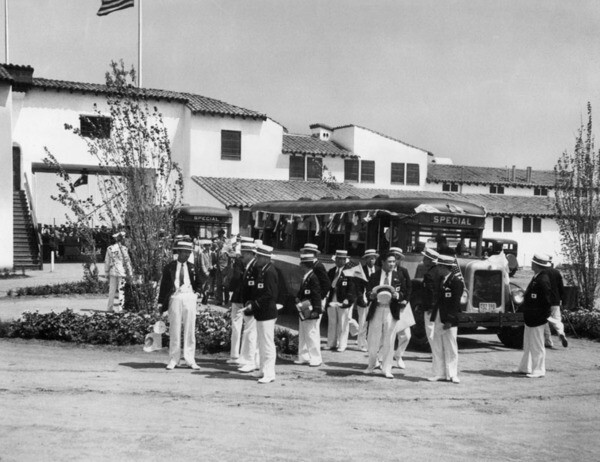Leimert Park and the 1932 Olympics

The 1932 summer Olympic games, held in Los Angeles, offered a chance for athletes traveling from around the world to experience the very first Olympic Village since the ancient Greeks pitched their tents on the plain of Elis.
Located in Baldwin Hills at the end of West Vernon Place and west of Crenshaw Boulevard, the Village consisted of 550 portable houses, designed and built by H.O. Davis, each measuring 24 by 10 feet. Each house contained two 10 by 10 foot rooms with a connecting shower. Each room housed two athletes, with two beds, two chairs, a dresser, and a lavatory bowl.
Davis enhanced the village with five dining halls, a post office, a radio station, a hospital, a dental laboratory, a fire station, a movie theater, and a 600 foot tall administration building. The total cost for the construction of the village came to be about $500,000.
1,836 male athletes lived there for the duration of the Games of the X Olympiad. And in accordance with gender norms of the time, 126 female athletes were excluded from the celebrated village and placed in the Chapman Park Hotel in Mid-Wilshire.


The Olympic committee was sensitive to the fact that sending an athlete around the world was very expensive. So they created the cost effective plan to sell every house and all furnishings at the end of the festivities, so they could only charge the athletes $2 a night to stay in the village.
There are no remnants of this village in Baldwin Hills today because every house was sold for $140, or $215 if furnished. Dozens of houses were sold to Californians, many were sent around the United States (including Hawaii), and some were even sent across the world to Germany, Japan, and South Africa.
An article in The Los Angeles Times at the conclusion of the games declared the Olympic Village a success: "'Never,' was the general opinion. 'You can't pen men of all nations together; men from countries, perhaps, who believe they have age-old hatreds; young men whose races, beliefs and ideals conflict.' But Los Angeles did it. They were not penned, these men from all over the world; they were offered a beautiful home that became more than home to them."
Frank Wykoff of Alhambra was a member of the 400-meter relay team in the 1932 games. He recalls, "I'll never forget the elation of living at the Olympic Village in Baldwin Hills. Being able to visit throughout the village, trying to overcome the language differences with representatives of 56 nations was a rare delight."


The Olympic Village was only a mile away from the nascent Leimert Park development. During the games, the Leimert Company seized the opportunity to showcase their homes to potential buyers making the drive to Baldwin Hills. An L.A Times article, from May of 1932, cites the company rushing to build model structures for their "Olympic Monterrey Home Show."
At the time of the games there were few residents living in the community, in part due to the economic crash of 1929 deterring the widespread sale of homes. The "open house" events promoting the Spanish revival "homes not houses," boasting an interior design by Barker Brothers, spurred the future growth of the planned community. In "Images of America: Leimert Park," authors Cynthia E. Exum and Maty Guiza-Leimert note, "City planning authorities chose Leimert Park as the ideal location of higher standards for the small home."
The marketing materials employed in the Leimert Company strategy included postcards, stills of idyllic family life, and portraits of beautiful women, typically in contemplative poses, against a backdrop of Spanish revival facades. Over the next two decades, as the neighborhood's business district began to grow and a diversity of dwellings became available for purchase and rent, Leimert Park flourished with residents, becoming the full-fledged, self-contained community that Walter H. Leimert had envisioned.




Sections of this article were excerpted from "The First-Ever Olympic Village Was Built in Los Angeles," previously published here.